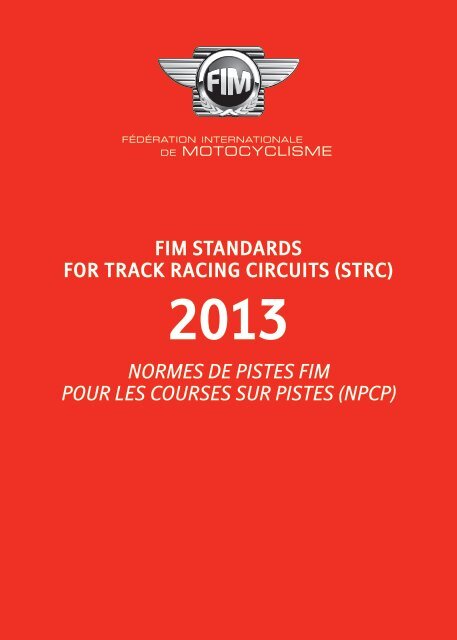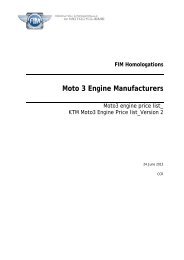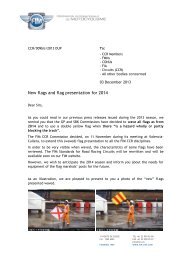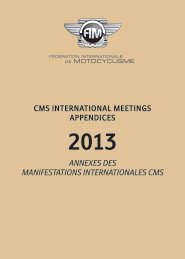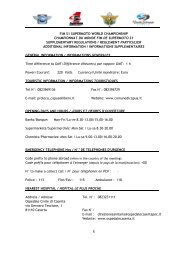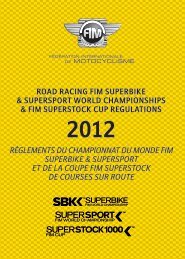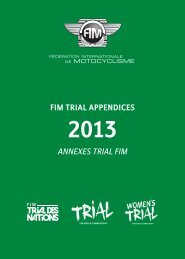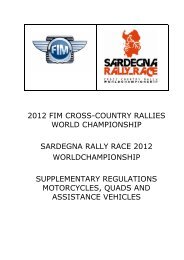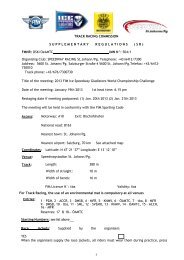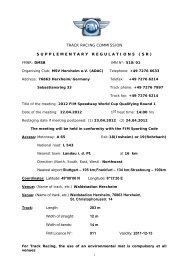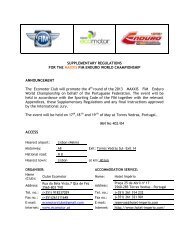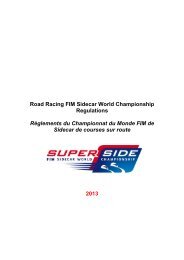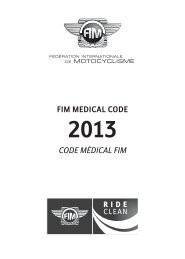FIM STANDARDS FOR TRACK RACING CIRCUITS (STRC ...
FIM STANDARDS FOR TRACK RACING CIRCUITS (STRC ...
FIM STANDARDS FOR TRACK RACING CIRCUITS (STRC ...
Create successful ePaper yourself
Turn your PDF publications into a flip-book with our unique Google optimized e-Paper software.
<strong>FIM</strong> <strong>STANDARDS</strong><br />
<strong>FOR</strong> <strong>TRACK</strong> <strong>RACING</strong> <strong>CIRCUITS</strong> (<strong>STRC</strong>)<br />
2013<br />
NORMES DE PISTES <strong>FIM</strong><br />
POUR LES COURSES SUR PISTES (NPCP)
<strong>FIM</strong> Standards for<br />
Track Racing Circuits<br />
(<strong>STRC</strong>)<br />
Normes de Pistes <strong>FIM</strong> pour les<br />
Courses sur Pistes<br />
(NPCP)<br />
Normes / Standards<br />
Illustrations / Drawings
CONTENTS / SOMMAIRE<br />
Appendix 079 <strong>FIM</strong> Standards for Track Racing<br />
Circuits (<strong>STRC</strong>).................................................. 1 - 34<br />
Track Inspection Report ..................................... 35 - 39<br />
Drawings ............................................................ 41 - 72<br />
Appendix A ......................................................... 73<br />
Annexe 079 Normes de Pistes <strong>FIM</strong> pour les Courses<br />
sur Pistes (NPCP).............................................. 1 - 34<br />
Rapport d’Inspection de Piste ............................ 35 - 39<br />
Illustrations......................................................... 41 - 72<br />
Annexe A ........................................................... 73<br />
Articles amended as from 1.1.2013 are in bold type<br />
<br />
<br />
EDITION 2013
APPENDIX 079<br />
<strong>FIM</strong> <strong>STANDARDS</strong> <strong>FOR</strong> <strong>TRACK</strong> <strong>RACING</strong> <strong>CIRCUITS</strong> (<strong>STRC</strong>)<br />
079.1 GENERAL ................................................................................. 3<br />
079.2 INSPECTION AND HOMOLOGATION PROCEDURE ............. 3<br />
079.2.1 Request for a track inspection .............................. 3<br />
079.2.2 Homologation procedure ...................................... 4<br />
079.2.3 Persons necessary for a track inspection ............ 5<br />
079.2.4 Expenses for a track inspection ........................... 5<br />
079.2.5 Duties of the track inspector ................................. 5<br />
079.2.6 Track inspection report ......................................... 5<br />
079.2.7 Allocation of an <strong>FIM</strong> World Championship ........... 5<br />
079.2.8 Liability ................................................................. 5<br />
079.3 <strong>TRACK</strong> LAYOUT ....................................................................... 6<br />
079.3.1 General principles ................................................ 6<br />
079.3.2 Recommended dimensions .................................. 6<br />
079.3.2.1 Length of the track ............................ 6<br />
079.3.2.2 Width of the track .............................. 7<br />
079.3.3 Banking ................................................................ 8<br />
079.3.4 Surfacing .............................................................. 8<br />
079.3.5 Maintenance ......................................................... 9<br />
079.3.6 Track requirements and equipment ..................... 9<br />
079.4 PROTECTIVE DEVICES AND BARRIERS ............................... 9<br />
.... 10<br />
079.4.2 Safety fence for Speedway, Long & Grass tracks 11<br />
079.4.3 Wooden fence ...................................................... 11<br />
079.4.4 Wire mesh fence .................................................. 12<br />
079.4.5 Safety barriers on temporary tracks ..................... 13<br />
079.4.6 Additional Protective Devices ............................... 14<br />
079.4.6.1 Homologation procedure of new<br />
Additional Protective Devices ........... 16<br />
079.4.7 Kick board ............................................................ 16<br />
1<br />
Normes / Standards
079.4.8 Access gates ........................................................ 17<br />
079.4.9 Neutral zone ......................................................... 17<br />
079.5 MARKING .................................................................................. 18<br />
079.5.1 Marking of the outer edge .................................... 18<br />
079.5.2 Marking of the inside edge ................................... 18<br />
079.6 INFIELD AND ADVERTISING ................................................... 19<br />
.................................................................... 19<br />
079.6.2 Advertising ........................................................... 19<br />
079.7 <strong>TRACK</strong> INSTALLATIONS ......................................................... 20<br />
079.7.1 Starting area ......................................................... 20<br />
079.7.2 Starting line .......................................................... 20<br />
079.7.3 Starting gate ......................................................... 21<br />
079.7.4 Signalling .............................................................. 22<br />
079.7.5 Light signals ......................................................... 22<br />
079.7.6 Referee’s box ....................................................... 23<br />
079.7.7 Pits ....................................................................... 24<br />
079.7.8 Changing room ..................................................... 24<br />
079.7.9 Washing of motorcycles ....................................... 24<br />
079.7.10 <strong>FIM</strong> Marketing requirements ............................. 25<br />
079.8 EMERGENCY SERVICE ........................................................... 25<br />
079.8.1 Medical service .................................................... 25<br />
079.8.2 First-aid room ....................................................... 25<br />
<br />
.......... 25<br />
079.8.4 Fuel ...................................................................... 26<br />
079.9 PRESS FACILITIES .................................................................. 26<br />
079.10 <strong>FIM</strong> SPEEDWAY GRAND PRIX WORLD CHAMPIONSHIP<br />
& <strong>FIM</strong> SPEEDWAY WORLD CUP ............................................. 26<br />
079.11 GUIDELINES <strong>FOR</strong> 1000CC <strong>TRACK</strong> <strong>RACING</strong><br />
SIDECAR <strong>TRACK</strong>S ................................................................... 26<br />
2<br />
Normes / Standards
APPENDIX 079<br />
<strong>FIM</strong> <strong>STANDARDS</strong> <strong>FOR</strong> <strong>TRACK</strong> <strong>RACING</strong> <strong>CIRCUITS</strong> (<strong>STRC</strong>)<br />
079.1 GENERAL<br />
The “<strong>FIM</strong> Standards for Track Racing Circuits” (<strong>STRC</strong>) determine the necessary<br />
standards for obtaining an <strong>FIM</strong> Track Racing licence.<br />
The <strong>FIM</strong> Championships must be held on Track Racing circuits which are<br />
homologated by the <strong>FIM</strong>, as stipulated in the <strong>FIM</strong> Sporting Code under Art. 10.8.<br />
079.2 INSPECTION AND HOMOLOGATION PROCEDURE<br />
079.2.1 Request for a track inspection<br />
Each FMN can apply for a track inspection by the <strong>FIM</strong> Administration. Every<br />
application for an <strong>FIM</strong> track inspection must be submitted together with an<br />
accurate plan-drawing of the track to the scale 1:500. This plan-drawing<br />
must also indicate the pits area, the changing room, the amenities and<br />
accommodation for the public, as well as all relevant dimensions and necessary<br />
information.<br />
An accurate construction-drawing of the safety barrier to the scale 1:10 must<br />
also be submitted.<br />
ONE EVENT <strong>TRACK</strong><br />
Inspection:<br />
<strong>STRC</strong> shall be used as guideline for the inspection, however at all times safety<br />
for the competitor (and spectators) must be the priority consideration.<br />
A pre-inspection of the venue must be held during the season preceding the that<br />
in which it is intended to stage the meeting (an absolute minimum of two months<br />
before the proposed event). Only in exceptional circumstances as agreed in<br />
advance, and in writing by the CCP will this stipulation be varied.<br />
A complete track inspection MUST also be completed a minimum of two days<br />
before the proposed event. The persons present at the inspection MUST<br />
include the appointed CCP inspector, an FMN delegate, the track Owner and/or<br />
organiser. It is also recommended that one rider shall be present.<br />
3<br />
Normes / Standards
079.2.2 Homologation procedure<br />
During the year, the <strong>FIM</strong> Administration will receive all documentation (track<br />
inspection reports, relevant remarks and conclusions contained in previous<br />
reports from the Jury Presidents and Referees) for all tracks hosting World<br />
Championship meetings.<br />
The <strong>FIM</strong> Administration will examine the documentation and make the following<br />
recommendations to the CCP, concerning the tracks that have been proposed by<br />
the FMNs for the meetings of the following year:<br />
a) The track is in order, and there are no remarks concerning the organisation.<br />
b) The FMNR and the organisers must be advised about the improvements to<br />
<br />
within the deadline set by the CCP.<br />
c) A re-inspection is requested for the track, or the FMNR is requested to<br />
change the venue to another track conforming to the standards.<br />
A track inspector will be appointed by the CCP in order to control and possibly<br />
recommend a homologation for:<br />
<br />
no current licence is in force.<br />
b) Existing tracks that have already been used for an <strong>FIM</strong> Championship, but<br />
have undergone substantially changes affecting the circuit or the safety<br />
installations.<br />
c) Existing tracks holding a valid licence, but where a serious accident<br />
has occurred due to the circuit, its safety installations or something else<br />
connected with the circuit.<br />
d) Any particular track following a request from the <strong>FIM</strong> Administration.<br />
<br />
inspection report will be homologated by the CCP and will receive an <strong>FIM</strong> track<br />
licence.<br />
The licence is valid for 3 years.<br />
In exceptional cases, an <strong>FIM</strong> track licence may be valid for only one or two<br />
years.<br />
4<br />
Normes / Standards
079.2.3 Persons necessary for a track inspection<br />
The appointed CCP track inspector will be accompanied by the following<br />
persons:<br />
<br />
<br />
<br />
A rider (this is highly recommended)<br />
079.2.4 Expenses for a track inspection<br />
The costs of the different track inspections are determined under Art. 7.6 of the<br />
<strong>FIM</strong> Financial Operating Guidelines.<br />
079.2.5 Duties of the track inspector<br />
At all inspections, the duty of the appointed track inspector is to examine all<br />
the installations and safety features and environmental elements at the circuit,<br />
and make recommendations, where required, to ensure that these, and the<br />
necessary services conform to the <strong>STRC</strong> and to the <strong>FIM</strong> Environmental Code.<br />
The <strong>FIM</strong> Administration may ask for a second inspection if essential work or<br />
faults remain.<br />
079.2.6 Track inspection report<br />
The appointed track inspector must complete the track inspection report by<br />
computer and send it by e-mail to the <strong>FIM</strong> Administration and FMN concerned<br />
within a few days of the track inspection. The original signed document must<br />
be sent by mail afterwards. In the track inspection report, the track inspector<br />
clearly writes down his remarks and proposals with regard to the measures to be<br />
adopted or improvements to be made.<br />
Once the inspection report has been sent, the FMN concerned has a maximum<br />
of three weeks to comment on the said report.<br />
079.2.7 Allocation of an <strong>FIM</strong> World Championship<br />
Each FMN which has been allocated an <strong>FIM</strong> Championship for the next year,<br />
must advise the <strong>FIM</strong> Administration of the venue(s) of the meeting(s) within the<br />
deadline stipulated by the CCP (1 st August of the current year).<br />
079.2.8 Liability<br />
No legal action can be taken against the <strong>FIM</strong>;; a track inspector or any <strong>FIM</strong><br />
<br />
installations or the track standards.<br />
5<br />
Normes / Standards
079.3 <strong>TRACK</strong> LAYOUT<br />
079.3.1 General principles<br />
The track must be on level ground and formed by two straights joined by two<br />
semi-circles.<br />
079.3.2 Recommended dimensions<br />
The dimensions of the track, as laid down, are recommendations which have to<br />
be followed as far as possible.<br />
For individual situations, the <strong>FIM</strong>/CCP can agree on other dimensions at its<br />
sole discretion.<br />
079.3.2.1 Length of the track<br />
Measured 1 metre from the inside edge:<br />
Speedway tracks: From 260 m to 425 m<br />
Ice tracks: From 260 m to 425 m<br />
Long & Grass tracks: From 350 m to 1300 m<br />
80cc Speedway: From 120 m to 200 m<br />
125cc Grass Track: From 200 m to 800m<br />
250cc Speedway: From 200 m to 425m<br />
250cc Long Track: From 350 m to 800m<br />
1000cc TR Sidecar From 300 m to 700 m<br />
Flat Track circuits:<br />
Short Track: From 120 m to 425 m<br />
Half Mile: From 426 m to 1100 m<br />
Mile: From 1101 m to2000 m<br />
TT: This is a Flat Track circuit that can include a jump and/or an extra succession<br />
<br />
on circuits designated as Short Track or Half Mile.<br />
6<br />
Normes / Standards
079.3.2.2 Width of the track<br />
The minimum width of the track shall be:<br />
Straights:<br />
Speedway tracks: 10 m<br />
Ice tracks: 10 m<br />
Long & Grass tracks: 12 m<br />
80cc Speedway: 7 m<br />
1000cc TR Sidecar:<br />
Track up to 400 m 10 m<br />
Track from 400 to 700m 12 m<br />
Flat Track circuits:<br />
Short Track: 10 m<br />
Half Mile: 12 m<br />
Mile: 12 m<br />
Bends:<br />
Speedway tracks: 14 m<br />
Ice tracks: 11 m<br />
Long & Grass tracks: 14 m<br />
80cc Speedway: 10 m<br />
1000cc TR Sidecar:<br />
Track up to 400 m 14 m<br />
Track from 400 to 700m 14 m<br />
Flat Track circuits:<br />
Short Track: 14 m<br />
Half Mile: 15 m<br />
Mile: 15 m<br />
7<br />
Normes / Standards
079.3.3 Banking<br />
Speedway, Long & Grass tracks:<br />
If there is some banking on the track, it must under no circumstances exceed 5%<br />
in the straight, 10% in the bends and must remain constant and grow from the<br />
inner edge to the safety fence.<br />
079.3.4 Surfacing<br />
For Speedway, Long & Grass tracks:<br />
Asphalt, macadam, concrete or similar solid base ground is not permitted, unless<br />
special authorisation is given by the CCP.<br />
The granulation of the material used for the top dressing must not exceed 7 mm.<br />
The depth of the dressing should not be less than 3 cm. In no circumstances<br />
should the granules be large enough to cause injury to the riders. The top<br />
dressing must not include toxic or other materials which could affect the health<br />
of the riders or be treated with salt, oil or any substances which could corrode or<br />
damage in any other way the components of racing motorcycles.<br />
Speedway tracks:<br />
The top surface must be granite, shale, brick granules or similar unbound<br />
material rolled in on the base ground.<br />
Ice tracks:<br />
The top surface must be ice with a minimum thickness of 10 cm.<br />
Long tracks:<br />
The top surface must be sand, shale, granite, brick granules or similar<br />
unbound material rolled in on the base ground.<br />
Grass tracks:<br />
<br />
8<br />
Normes / Standards
079.3.5 Maintenance<br />
Speedway, Long & Grass tracks:<br />
The track should be properly watered down in ample time before the meeting<br />
to ensure satisfactory racing and to protect the public and the riders from dust.<br />
Water must also be available to control dust during the racing.<br />
To preserve the evenness of the top dressing, it should be graded as necessary<br />
between heats. Graders should be constructed so that they replace the top<br />
dressing on the inside area of the track from the outside where it has been<br />
thrown during racing.<br />
Ice tracks:<br />
To remove loose ice, the surface must be scraped or brushed as necessary, but<br />
at least after every four races. The loose ice shall be removed from the surface<br />
of the track so that the edge marking remains clearly visible to the riders and the<br />
Referee. For this purpose power-driven scrapers or brushes must be provided.<br />
079.3.6 Track requirements and equipment<br />
The track is in order when the track surface ensures satisfactory riding and<br />
overtaking. In order to obtain this, all necessary equipment such as graders,<br />
water tankers, etc. have to be provided at all Track Racing meetings.<br />
079.4 PROTECTIVE DEVICES AND BARRIERS<br />
The use of <strong>FIM</strong> homologated APDs is compulsory at all <strong>FIM</strong> Speedway and<br />
Long Track (NB: for Long Track recommended in 2013 and compulsory<br />
in 2014) World Championship meetings (500cc) except in the following<br />
circumstances:<br />
For speedway and Long Track <br />
the requirement for the use of an approved APD may be relaxed at the sole<br />
discretion of the CCP after full consideration of the remarks and report from the<br />
appointed <strong>FIM</strong> Track Inspector.<br />
9<br />
Normes / Standards
The track must be surrounded by up to 3 barriers:<br />
Barrier 1<br />
A spectator barrier must be provided, at least 2 m high, prohibiting public access<br />
to the neutral zone. The stanchions must not protrude above the top of the<br />
barrier and all sharp edges must be covered. This barrier may be dispensed with<br />
if the distance from the bends to the public zone is large enough, as shown in<br />
the track inspection report.<br />
Barrier 2<br />
A barrier at least 1.2 m high, and (+/-) 1.5 m wide, made of snow or formed by<br />
bales must be erected in front of barrier 1. Bales (straw or plastic material) must<br />
be suitably covered and retained in place by a rope type system that will allow<br />
them to give slightly under impact.<br />
Barrier 3<br />
A barrier at least 80 cm high is erected about 1 m or more in front of barrier 2. It<br />
can be composed of bales (straw or plastic material) suitably covered, and must<br />
be free standing in order to be able to slide under impact.<br />
079.4.1.2<br />
<br />
safety fence for traditional speedway racing:<br />
Barrier 1<br />
A spectator barrier must be provided, at least 2 m high, prohibiting public access<br />
to the neutral zone. The stanchions must not protrude above the top of the<br />
barrier and all sharp edges must be removed, or fully protected and covered.<br />
This barrier may be dispensed with at the sole discretion of the CCP following<br />
the report and remarks of the <strong>FIM</strong> appointed track inspector if the distance from<br />
the bends to the public zone is large enough so as not to present any obvious<br />
danger to the public.<br />
Barrier 1A - The homologated speedway fence 1.2 m high and a minimum of 2 m<br />
distance from Barrier 1<br />
In the bends:<br />
Barrier 2 approx. 1 m from Speedway fence<br />
A barrier at least 1.2 m high, and (+/-) 1.5 m wide, made of snow or formed by<br />
bales of an agreed material (i.e. straw or plastic) must be erected in front of<br />
barrier 1A.<br />
10<br />
Normes / Standards
Bales (straw or plastic material) must be suitably covered and retained in place<br />
by a rope type system or similar that will allow them to give slightly to absorb<br />
energy under impact.<br />
This row of bales must commence immediately on entry and continue throughout<br />
the entire bend and into the following straight for a distance of approximately 2<br />
metres.<br />
An appropriate safety fence board (or similar item of agreed material) must<br />
be overlaid and suitably secured starting from the speedway safety fence and<br />
<br />
form an uninterrupted smooth line into the bends.<br />
Barrier 3<br />
A barrier at least 80 cm high is erected about 1 m or more in front of barrier 2. It<br />
can be composed of bales (straw or plastic material) suitably covered, and must<br />
be free standing in order to be able to slide under impact.<br />
079.4.2 Safety barriers for Speedway, Long & Grass tracks<br />
A safety fence must be constructed to prevent damage or injury to a rider, an<br />
<br />
A vertical safety fence must surround the track and be of a minimum height of<br />
1.2 m.<br />
A shock absorbing type of fence is recommended.<br />
The safety fence can be constructed with wooden planks, board material,<br />
plastics, rubber, wire-mesh or other protective approved material. However it<br />
must be constructed in order to absorb kinetic energy if a rider crashes into it.<br />
079.4.3 Wooden fence<br />
A fence built with wooden planks must be a minimum of 20 mm and a maximum<br />
of 25 mm in thickness. A fence built with plywood board or laminated wood must<br />
be a minimum of 16 mm and a maximum of 25 mm in thickness. It should be<br />
properly proofed against rot or other deterioration. If wooden planks are used,<br />
they must be erected vertically.<br />
11<br />
Normes / Standards
The fence must be supported on the outside by suitable stanchions, which are<br />
<br />
fence.<br />
The inside surface of the whole fence must be painted in order to contrast clearly<br />
with the colour of the track surface.<br />
Throughout its entire length, the top of a wooden fence or any other approved<br />
<br />
079.4.4 Wire mesh fence<br />
If the fence is a wire-mesh construction, the wire must be made in steel and<br />
have a minimum diameter of 2,5 mm. The width between the mesh must not<br />
exceed 50 mm. The wire mesh must be carried on the outside by suitable<br />
<br />
protrude above the top of the mesh. An exception is the suspended wire-mesh<br />
fence.<br />
Each stanchion must be equipped with one or more coil springs to which the<br />
wire mesh is attached. Alternatively, polystyrene, phenol-formaldehyde foam<br />
or similar approved crushable material, which will compress and absorb kinetic<br />
energy on impact, may be employed instead of springs. Such material must<br />
extend the full exposed length of each stanchion.<br />
The mesh must be supported by three horizontal strain wires of a minimum<br />
diameter of 6 mm.<br />
The upper wire must be located at the top of the mesh, and second wire<br />
approximately 50 cm from the top. The third wire must be located at the bottom.<br />
The wires must be securely attached to the stanchions and must go through the<br />
net at the top and the bottom of the net at the full length of the wires and not<br />
mounted with plastic cable ties. Strain wires must be kept taut at all times.<br />
For wire-mesh fences, the capping must be made of strong canvas, rubber,<br />
<br />
the mesh. The capping must be securely fastened.<br />
Inside the net, it is recommended to have a cover in suitable material<br />
overlapping the top of the fence and reaching down under the kick-board.<br />
12<br />
Normes / Standards
079.4.5 Safety barriers on temporary tracks<br />
Alternatives to the wood or wire mesh fence, where authorised, are described<br />
below:<br />
Alternative I<br />
Straw bales of at least 80 cm in height are placed side by side without spacing<br />
around the track. The bales are secured in position by roping or like manner<br />
to ensure that they cannot be knocked onto the track. Outside the bales a<br />
catching net of a wire mesh construction, not less than 1 m in height, is erected<br />
at a distance of not less than 3 m. If space permits, the widths of the neutral<br />
<br />
neutral zone should be provided.<br />
Alternative II<br />
The outer edge of the track is marked by a continuous white line or by very small<br />
<br />
run-off zone must be at least 1% of the track length but not less than 4 m.<br />
a) If these conditions are met, the safety fence may be 1,10 m high and<br />
without a kick board. Outside, and adjacent to the safety fence, there must<br />
be a neutral zone with a suitable barrier to deny access to the zone by the<br />
public. The width of the neutral zone must be a minimum of 2 m when the<br />
run-off zone is between 4 m and 6 m in width and 1 m in width when the<br />
run-off zone is over 6 m in width.<br />
b) The run-off zone is surrounded by rope-and-stake wrecking fences, two<br />
on the straights and three on the bends, with neutral zones between them;;<br />
the height of the wrecking rope from the ground should be approximately<br />
75 cm;; the width of the neutral zone on the straights should be not less than<br />
2 m, and of the neutral zones on the bends not less than 3 m.<br />
For sidecar racing, there should be four wrecking fences on the bends.<br />
At 3 m from the outside of the outer wrecking fence, a wire mesh barrier should<br />
be provided in order to deny access of the public to the neutral zones.<br />
Obstacles, except those that are necessary for the organisation of the meeting,<br />
are not permitted in neutral zones.<br />
13<br />
Normes / Standards
079.4.6 Additional Protective Devices<br />
<br />
<br />
The Homologation is valid only for the tested model/product. New models/<br />
products must undergo and obtain a new homologation in accordance with the<br />
relevant tests.<br />
If an APD is used permanently or temporarily, it must be erected against a<br />
<br />
secondary fence must be approved by the <strong>FIM</strong>. There should be no free space<br />
between the APD and the secondary fence.<br />
The height of the APD shall not be less than 1.2 m. The APD must be solidly<br />
connected to the top and, as solidly as possible, to the bottom of the secondary<br />
fence or to the ground in order to avoid a possible rising during impact.<br />
The lower part of each APD must be equipped with a kick board approximately<br />
30 cm high according to Art. 079.4.7.<br />
If constructed by the means of modules, these shall be solidly attached and a<br />
<br />
to be provided at the end of each module. The same applies for the kick board.<br />
<br />
Contingency ADP must be available in order to be able to quickly replace a<br />
punctured or damaged unit.<br />
The co-ordinates of the manufacturers and distributors of homologated<br />
Additional Protective Devices are listed in Appendix A – The updated list is<br />
<br />
<br />
device/<br />
14<br />
Normes / Standards
The following Track Racing Additional Protective Devices are homologated (see<br />
manufacturers’ and/or distributors’ co-ordinates in Appendix A and the updated<br />
):<br />
Type A (Long Track, Grass Track and Speedway)<br />
Tony Briggs “No Pain Barrier”, “Catching Air”, “Air Net”<br />
ADMAR Speedway Air Barrier”<br />
SIDIJK BV “Sidijk Impact Protection System” (20 metres long) and<br />
Sidijk Impact Protection System 2.0<br />
Type B (Speedway)<br />
Champion Products Ltd “T.P.B.S” and “TIBS”<br />
<br />
Approved APDs shall be re- inspected by an <strong>FIM</strong> appointed inspector and<br />
<br />
either one or two further seasons depending on their condition.<br />
After a maximum seven seasons of use, the APD depending on the result<br />
of the inspection will need to be either fully or partially replaced.<br />
If the APDs sections are partially replaced then it must be in conjunction<br />
with Art 079.04 (dangerous parts of the fence) to ensure that these<br />
areas are adequately covered with new modules of APD. The remaining<br />
replacements should be completed prior to the commencement of the<br />
following season.<br />
An Inspection of an APD may be required by <strong>FIM</strong> at ANY time should there<br />
<br />
Where work is required to the APD to an acceptable standard the Track<br />
License of the circuit or circuits where the APD is in use will be considered<br />
<br />
APDs may be granted extended use in exceptional circumstances, (i.e.<br />
where they are only installed and used once or twice a year), following<br />
inspection by and the agreement of the <strong>FIM</strong>, the owner and manufacturer.<br />
15<br />
Normes / Standards
079.4.6.1 Homologation procedure of new Additional Protective Devices<br />
The test procedure as well as the appointed laboratories can be obtained from<br />
the <strong>FIM</strong> Administration.<br />
Performance tests must be carried out in a laboratory by the applicant. The<br />
<br />
<br />
well as a recent document certifying the calibration of the instruments. The CCP/<br />
<strong>FIM</strong> has the right to appoint an inspector at these tests. Requests must be made<br />
to the <strong>FIM</strong> Administration at least 3 months before the tests are due to be carried<br />
out.<br />
To obtain the homologation, the applicant must submit to the <strong>FIM</strong> Administration:<br />
- Pictures of the module showing in detail the overlapping of the kick<br />
<br />
- The video recording of the tests performed in the laboratory<br />
- Copies of the report of these tests<br />
<br />
recognised laboratory.<br />
079.4.7 Kick board<br />
The lower part of the safety fence must be equipped with a kick board,<br />
approximately 30 cm height. It must be constructed in such a manner that it<br />
will prevent damage to riders and equipment. At the same time it shall connect<br />
up the sections of the safety fence. For some type of fence the kick board<br />
may not be necessary. Special permission can only be given by the <strong>FIM</strong>/CCP<br />
Administration.<br />
The sections of the kick board must be overlaid in the direction of racing and<br />
painted in order to contrast with the colour of the track surface. For temporary<br />
tracks, kick boards are not required on the safety barriers.<br />
The use of a hard, rubber type compound is recommended for the construction<br />
of a kick board.<br />
Note: The use of metal kickboard is not allowed.<br />
16<br />
Normes / Standards
079.4.8 Access gates<br />
The number of access gates in the safety fence must be the minimum necessary<br />
<br />
located at any part of the track where riders may be expected to ride into the<br />
fence.<br />
Gate stanchions must not be higher than the height of the fence, and be covered<br />
<br />
on the outside of the stanchions and gate frames (in relation to the track).<br />
In any type of fence, the slot for the starting gate should not be wider than<br />
necessary for providing operating clearance. The slot must terminate at least<br />
30 cm above the track surface, and the kick board must be continuous below the<br />
slot.<br />
079.4.9 Neutral zone<br />
Ice Racing Tracks:<br />
The width of the neutral zone should not be less than 2 m in the straights and<br />
3 m in the bends, with a suitable barrier (2 m high protective fence) to deny<br />
access to the zone by the public.<br />
Flat Track Tracks:<br />
The neutral zone will follow the regulations of the track racing discipline for which<br />
the circuit is traditionally licensed i.e. discipline Speedway, Long Track and Ice<br />
Racing.<br />
Speedway tracks:<br />
The width of the neutral zone should not be less than 2 m, with a suitable barrier<br />
to deny access to the zone by the public.<br />
Long & Grass tracks:<br />
The width of the neutral zone should not be less than 2 m in the straights and<br />
3 m in the bends, with a suitable barrier to deny access to the zone by the public.<br />
17<br />
Normes / Standards
Temporary tracks: (except for Ice Racing tracks)<br />
There must be a neutral zone on the outside of the safety fence or barrier. This<br />
neutral zone must be at least 2 m in width on the straights and 3 m in width in<br />
the bends, with a suitable barrier to deny access to the zone by the public.<br />
Obstacles, are not permitted unless necessary to serve the organisation of the<br />
meeting. Any lighting posts or other obstacles that could cause damage or injury<br />
situated in the neutral zone, within 2 or 3 m minimum distance from the fence<br />
must be adequately covered with straw bales or cushioning material at least<br />
60 cm in width and 2 m in height towards the direction of racing.<br />
079.5 MARKING<br />
The inside and outer edges of the track must be clearly marked.<br />
079.5.1 Marking of the outer edge<br />
If there is no safety fence on the outer-edge of the track, the outer-edge must be<br />
<br />
surrounded by a run off zone.<br />
The public must be safely protected from the racing by a suitable barrier of rope,<br />
net or a similar protective material.<br />
079.5.2 Marking of the inside edge<br />
Speedway, Long & Grass tracks and Flat Track:<br />
The inside edge must be kept visible throughout the meeting, and marked by a<br />
continuous line of a colour that contrasts with the track surface. The line may be<br />
indicated by means of white powder or whitewash, not less than 15 cm wide, or<br />
by a wood or concrete kerb painted in contrast to the surface and not less than<br />
5 cm wide. A kerb must not protrude above the surface by more than 5 cm and<br />
must enable a motorcycle to ride over it safely in an emergency situation.<br />
<br />
placed 1 m inside a white inner edge line.<br />
Ice tracks:<br />
The inside edge must be kept visible throughout the meeting and marked by a<br />
continuous line in a bright, contrasting colour (such as red or blue) not less than<br />
15 cm wide. The line, marking the inside of the track in the bends, must not be<br />
painted nearer than 15 cm to the edge of the track.<br />
18<br />
Normes / Standards
079.6 INFIELD AND ADVERTISING<br />
<br />
<br />
that a rider may safely ride on it, should he be forced off the track.<br />
In exceptional circumstances, obstacles, which cannot be removed, may be<br />
permitted providing that they are not closer than 4 m to the inner edge of the<br />
track. These obstacles must be amply covered with straw bales, polystyrene,<br />
phenol formaldehyde or similar crushable material to a minimum height of 2 m<br />
from the ground level.<br />
For tracks exceeding 700 m in length, the clerk of the course and the doctor may<br />
<br />
the track in case of an emergency. In addition, an ambulance may be stationed<br />
<br />
Otherwise, vehicles which may be required for use from time to time, such as<br />
water tankers, tractors and graders, must be accommodated outside the circuit<br />
when not in use, whenever possible.<br />
079.6.2 Advertising<br />
<br />
boards and structures that are necessary for the organisation of the meeting.<br />
Portable advertising boards shall not exceed 1 m high, and must either be<br />
<br />
metal or plastic sheets mounted on light weight frames so that they can collapse<br />
easily if struck. They must be placed more than 4 m from the inner edge of the<br />
track and be inclined towards the direction of racing.<br />
Any banner, poster or other display on the inside of a board fence is only<br />
permitted if it is painted on the fence or it must be completely secured by<br />
adhesive.<br />
19<br />
Normes / Standards
079.7 <strong>TRACK</strong> INSTALLATIONS<br />
079.7.1 Starting area<br />
According to the number of starters, the starting area must be divided into equal<br />
parts by longitudinal lines of 5 cm width. These lines, on the track surface, are<br />
extending back for 1 m from the starting line.<br />
All markings in the starting area must be clearly visible to the Referee at all times<br />
throughout the meeting.<br />
For Long Track: the minimum distance between the lines is 1.5 m for solos<br />
and 2.5 m for sidecars<br />
For Grass Track: the minimum distance between the lines is 2 m for solos and<br />
3 m for sidecars<br />
All lines in the starting area must be marked with powder that contrasts with the<br />
colour of the track surface, and must be renewed after each race.<br />
On Ice tracks the lines must be marked in a bright contrasting colour (such as<br />
red or blue) and maintained visible throughout the meeting.<br />
For Flat Track:<br />
Depending on the number of riders taking part in a heat (maximum 5 per row)<br />
the start line will be marked as follows:<br />
Row One – Will be the Start/Finish line<br />
Row Two – will be marked with a single line positioned 8 meters behind the<br />
Start/Finish line<br />
Subsequent additional rows as required will also be marked a distance of 8<br />
metres behind the preceding row.<br />
All line markings are to be made using a powder or similar that contrasts with the<br />
colour of the track surface.<br />
079.7.2 Starting line<br />
<br />
at least 5 cm wide, must be marked across the full width of the track at a right<br />
angle to the inner edge.<br />
20<br />
Normes / Standards
Speedway and Ice tracks:<br />
The starting line should be positioned in the middle of the straight, and if this is<br />
<br />
Long & Grass tracks:<br />
The starting line should be positioned in the middle of the straight, or if this is not<br />
<br />
Flat Track:<br />
The Starting line should usually be positioned approximately in the middle of<br />
a straight but may be positioned in different places depending of the tracks/<br />
competition.<br />
079.7.3 Starting gate<br />
Vertical stanchions, approximately 3 m in height, must be securely mounted one<br />
<br />
placed approximately 1 m from the inner edge line and should be covered in an<br />
approved manner with straw bales or cushioning material at least 60 cm in width<br />
and 2 m in height towards the direction of racing.<br />
Each stanchion must be equipped with 2 sliders, to carry the tapes, with a slider<br />
stop at a height of approximately 2.9 m and with a pulley at the top for the elastic<br />
cord which raises the slider when it is released.<br />
A solenoid-and-pawl, an electro magnet or similar mechanism must retain the<br />
slider when it is in the lower position to give the required height of 53 cm for the<br />
bottom tape. Two or three tapes must be attached to the sliders of the starting<br />
gate with rubber bands at each end which, when not stretched, are no longer<br />
than 15 cm and not wider than 2.5 cm.<br />
Metal clips, hooks or other forms of metal connections must not be attached to<br />
the tapes or bands.<br />
The tapes must be made of an easy breakable material.<br />
The tapes must be of a contrasting colour with the colour of the track surface.<br />
For Ice tracks they should be preferably red or blue.<br />
The gate releasing mechanism must only be controlled from the switchboard.<br />
<br />
used for signalling starts.<br />
21<br />
Normes / Standards
079.7.4 Signalling<br />
<br />
<br />
Start<br />
All riders stop<br />
Last lap<br />
Finish<br />
Horn, siren or bell audible in the pits and near the starting<br />
<br />
<br />
with a disc of a diameter of at least 45 cm indicating the<br />
rider’s colour:<br />
079.7.5 Light signals<br />
Final warning of<br />
limited time for<br />
riders to reach the<br />
start line.<br />
Normes / Standards<br />
<br />
A green starting light shall be provided at least 10 m in front of the starting line,<br />
clearly visible to the riders and in direction of the racing. For Long & Grass<br />
tracks, this green starting light and a red stop light must be positioned max. 30 m<br />
in front of the starting line and about 2 meters above the track level.<br />
A supplementary green light, operated in conjunction with the green starting light<br />
must be located 10 m in the rear of the starting line, and be easily visible to the<br />
starting marshal when he is facing the direction of racing.<br />
<br />
corresponding to the riders’ helmet colours (red, blue, white, yellow, green, black<br />
& white). They must preferably be assembled in a vertical tower and visible to<br />
any part of the stadium. All lamps must be of high intensity type.<br />
<br />
minute horn, siren or bell, must be placed as follows:<br />
a) one in the pits, clearly visible to all riders<br />
b) one near the starting gate<br />
22
positioned not more than 4 metres from the track and easily visible by the riders,<br />
<br />
siren that operates with the lights.<br />
All lights must be of high intensity type and be easily visible to the riders.<br />
The lights must be located at least 60 cm outside the safety fence or barrier, but<br />
not more than 4 m away.<br />
If mounted on the stanchions inside the neutral zone, the stanchions must<br />
incorporate a pivot at a height of not more than 30 cm from track level, so that,<br />
if it is struck by a rider or machine, the upper part of the stanchion will easily<br />
collapse in the direction of racing.<br />
079.7.6 Referee’s box<br />
An observation box, placed adjacent to the starting area, must be provided for<br />
<br />
unhindered, overall view of the track and the starting area.<br />
This accommodation must have an adequate roof in order to protect the Referee<br />
in case of wet weather. The Referee’s box must be located on the outside of the<br />
track so that the Referee can align himself with the starting line.<br />
The box must be located outside the neutral zone or zones and be equipped<br />
with a switchboard for operating the starting gate, the signal lamps and the<br />
warning horn, siren or bell. The Referee’s box must have a proper telephone<br />
installation for communication with the starting marshal, the pits’ marshal, the<br />
announcer and provide ample facilities for writing.<br />
The switchboard should be equipped with easily understandable indicators for<br />
the functioning of the switches. The wiring must ensure that:<br />
<br />
starting lamp (and its subsidiary lamp) has been switched on.<br />
b) The switch to raise the starting gate will not operate until the green starting<br />
lamp (and its subsidiary lamp) has been switched on.<br />
c) The green starting lamp (and its subsidiary lamp) will automatically switch off<br />
ten seconds after the starting gate has been released.<br />
d) Possibility to switch off the green light without releasing the tapes.<br />
23<br />
Normes / Standards
can be switched on and off by the Referee, must be provided in the Referee’s<br />
box.<br />
<br />
races must be placed in the following order: Red, blue, white and yellow and,<br />
additionally for Long & Grass track (where applicable) green and black & white.<br />
079.7.7 Pits<br />
Each rider must be provided with a minimum of 8 m 2 of space on hard ground.<br />
At all tracks, covered accommodation must be provided to give protection in<br />
case of bad weather.<br />
Drinking water and washing facilities must be provided throughout the meeting.<br />
There must be a minimum of one toilet reserved for riders, and placed nearby<br />
the pits.<br />
Facilities for collection of rubbish, oil and tyres must be available in the pits.<br />
079.7.8 Changing room<br />
<br />
within the pits area or nearby.<br />
These facilities must include toilets, water supplies, showers and seating.<br />
079.7.9 Washing of motorcycles<br />
Washing of motorcycles at the venue must be carried out at places with washing<br />
facilities only. Cleaning (wiping with detergents, for example) or rinsing with pure<br />
water (without the addition of any chemical products), is permitted and cleaning<br />
must be carried out in accordance with the Environmental Code and on the<br />
following conditions:<br />
a) That a non-porous wash area has been provided, complete with a drain and a<br />
separate oil collector.<br />
Or,<br />
<br />
capacity to contain all the waste arising from motorcycle washing, and the<br />
contents are removed by a vacuum tanker for disposal in accordance with local<br />
regulations.<br />
24<br />
Normes / Standards
079.7.10 <strong>FIM</strong> Marketing requirements<br />
For the <strong>FIM</strong> Track Racing Championships and Prize events, the organiser<br />
must follow the <strong>FIM</strong> guidelines and recommendations regarding the<br />
advertising, backdrops, press and TV Management.<br />
079.8 EMERGENCY SERVICE<br />
079.8.1 Medical service<br />
<br />
<br />
<br />
<br />
the middle of each bend, and well away from the edge of the track.<br />
The exact whereabouts of the doctor throughout the practice and the meeting<br />
must be known by the Clerk of the Course.<br />
079.8.2 First-aid room<br />
At least one bed, hot water supplies and adequate medical stores must be<br />
provided in a room or tent from which non-medical staff can be excluded.<br />
<br />
<br />
<br />
<br />
<br />
<br />
powder extinguishers.<br />
<br />
<br />
<br />
or near the starting area.<br />
<br />
<br />
<br />
<br />
Tools and spare parts for fast repair of any part of a safety fence must be<br />
available.<br />
25<br />
Normes / Standards
079.8.4 Fuel<br />
Provision of fuel<br />
Fuel may only be provided from a point a minimum of 7 metres from any other<br />
vehicle. The area must be secured, and the supplier must display “no smoking”<br />
and “no naked light” signs. In addition the supplier must comply with appropriate<br />
local regulations.<br />
079.9 PRESS FACILITIES<br />
The following minimum facilities for the Press must be provided in 1 workroom<br />
with tables, chairs and typewriters:<br />
1 fax machine with direct lines<br />
1 telephone with direct lines<br />
1 photocopy machine<br />
Internet connection<br />
Telephone communications may be charged to the journalists. The only persons<br />
authorised in this room are the media (TV, journalists, photographers) and <strong>FIM</strong>/<br />
<br />
It is recommended to provide the press with free drinks and a small buffet.<br />
079.10 <strong>FIM</strong> SPEEDWAY GRAND PRIX WORLD CHAMPIONSHIP<br />
& <strong>FIM</strong> SPEEDWAY WORLD CUP<br />
The rules of the present Appendix apply for all tracks used for the <strong>FIM</strong><br />
Speedway Grand Prix World Championship and the <strong>FIM</strong> Speedway World Cup,<br />
except where different or added to by Regulation 077 “<strong>FIM</strong> Speedway Grand<br />
Prix World Championship Rules” and Regulation 078 “<strong>FIM</strong> Speedway World<br />
Cup”.<br />
079.11 GUIDELINES <strong>FOR</strong> 1000CC <strong>TRACK</strong> <strong>RACING</strong> SIDECAR <strong>TRACK</strong>S<br />
Guidelines for the Inspection and Licensing of the Track racing sidecar 1000cc<br />
tracks<br />
26<br />
Normes / Standards
Introduction<br />
As the governing body for motorcycle sport, the <strong>FIM</strong> is committed to promoting<br />
safe motorcycle sport throughout the world.<br />
These Track Guidelines have been published by <strong>FIM</strong> with the aim of assisting<br />
an FMN, Clubs, Organizers and Promoters, and <strong>FIM</strong> approved Track Inspectors,<br />
to conduct an inspection assessment and where appropriate, homologation<br />
of motorcycle tracks. The purpose is to facilitate a level of uniformity and in<br />
doing so contributing to safety and fairness for all competitors/participants and<br />
<br />
Not withstanding these guideline however, the safe operation and management<br />
of tracks and events, remains the responsibility of the staging FMN, Clubs,<br />
Organizers, Track Operators and Event Promoters.<br />
For the purposes of obtaining a Track License to conduct an international event,<br />
additional measures may be required to comply with <strong>FIM</strong> standards. The <strong>FIM</strong><br />
publishes these guidelines assist in the development of tracks for international<br />
competition.<br />
Support facilities at Tracks:<br />
It is the responsibility of the staging FMN, Club, Organizer, Track Operator<br />
and Promoter to ensure compliance with all local, state and territory or<br />
federal laws, regulations and codes, regarding the safe design, construction,<br />
management and operation of the track and all support facilities. Also that the<br />
track anal associated facilities are fully compliant with any planning, building,<br />
environmental, occupational health and safety, public safety or other local, state<br />
or territory laws, regulations or codes.<br />
<strong>FIM</strong> cannot and does not conduct any business or undertaking to ensure that<br />
<br />
<strong>FIM</strong> licensed facilities are not put at risk.<br />
27<br />
Normes / Standards
Recommended Track Standard Guidelines For Track Racing 1000cc<br />
Sidecars<br />
1 Track Layout<br />
a) Tracks should be as near to level as possible and formed by two straights<br />
joined by two semi-circular corners.<br />
b) Track layout must be initially designed with all grades of competing riders in<br />
mind.<br />
c) Competitor safety and spectator viewing must both be considered when<br />
designing and constructing the track.<br />
d) Consideration should be given to drainage in the event of heavy rainfall.<br />
2 Length, Width and Banking<br />
According to <strong>STRC</strong> 079.3.3<br />
3 Surface<br />
a) The top surface must be granite, shale, brick granules, or similar unbound<br />
material rolled in on the base ground.<br />
b) The grain size of the material used for top dressing must not exceed 7mm in<br />
diameter.<br />
c) The depth of the dressing should be not less than 30mm.<br />
4 Maintenance<br />
To preserve the evenness of the top dressing, it should be graded as necessary<br />
between races.<br />
Graders should be constructed so that they replace the top dressing on the<br />
inside area of the track from the outside where it has been thrown during racing.<br />
Note: Special consideration should be given to drainage in the construction of<br />
the track to guard against the effect of adverse weather conditions.<br />
5 Lighting<br />
Lighting must be of a standard that provides clear and even visibility across the<br />
entire racing surface. It shall be free of shaded areas and provide a minimum of<br />
200lux measured at the track surface.<br />
6 Referee’s Box<br />
An observation box, placed adjacent to the starting area, must be provided for<br />
the referee and must be in accordance with Art. 079.7.6.<br />
28<br />
Normes / Standards
7 Pit area<br />
There shall be adequate pit facilities approved by the <strong>FIM</strong> consisting of the<br />
following:<br />
a) Each rider must be provided with a minimum of 8 m 2 of space on hard<br />
ground.<br />
b) At all tracks, covered accommodation must be available to give protection in<br />
case of bad weather.<br />
c) There must be a minimum of one toilet reserved for riders, and placed near<br />
the pits.<br />
d) Facilities for collection of rubbish, oil and tyres must be available in the pits.<br />
8 Washing Zone for Motorcycles<br />
Please refer to the Art. 079.7.9.<br />
9 Public and Rider Safety:<br />
a) On the race track and other relevant areas, there must be a minimum of<br />
two lines of protection between competitors/machines, and members of the<br />
public:<br />
<br />
accordance with paragraph 10 as below.<br />
ii. the second line of protection, also known as the Spectator Fence, shall be in<br />
accordance with paragraph 11 as below.<br />
iii. a neutral zone, as detailed in paragraph 13 below shall exist between the<br />
safety fence and the spectator fence.<br />
<br />
A safety fence must be constructed to prevent damage or injury to a rider, an<br />
<br />
a) A vertical safety fence must surround the track and be of a minimum height<br />
of 1.2 metre or as otherwise required by Local or State Legislation.<br />
b) The fence may be constructed of wooden planks, other approved board<br />
material, plastics, rubber belting, wire-mesh or other protective approved<br />
materials approved by the <strong>FIM</strong>. The material shall be constructed in order to<br />
absorb kinetic energy if a rider crashes into it.<br />
c) Round-headed coach bolts must be used for fastening, and replacing “tek<br />
screws” (or similar) to increase rider safety.<br />
d) Concrete barriers or steel sheeting can be approved for existing venues only.<br />
29<br />
Normes / Standards
10.1 Wooden Fence<br />
A fence constructed of wooden planks must:<br />
a) be at least 25mm in thickness,<br />
b) be adequately proofed against rotting and other deterioration,<br />
c) where of plank construction must be erected horizontally,<br />
<br />
<br />
the fence.<br />
e) have the inside surface of the entire fence painted to clearly contrast with the<br />
colour of the track surface.<br />
<br />
<br />
rounded cap. This cap must not overhang on the inside of the fence.<br />
10.2 Board Material<br />
A fence constructed of other approved board material must:<br />
a) be at least 19mm in thickness,<br />
b) be correctly proofed against rotting and other deterioration,<br />
<br />
<br />
into the ground. Stanchions must not protrude above the top of the fence.<br />
d) have the inside surface of the entire fence painted to clearly contrast with the<br />
colour of the track surface.<br />
<br />
<br />
rounded cap. This cap must not overhang on the inside of the fence.<br />
10.3 Kick Board<br />
The base of the safety fence, irrespective of the type of construction (other than<br />
concrete, timber, or rubber belting), must be equipped with a kick board on the<br />
track side of the fence, 300 mm in height and constructed of wood, or other<br />
approved material.<br />
<br />
<br />
fence.<br />
<br />
<br />
ground. These supports must be separated from the fence stanchions.<br />
c) sections of the kickboard must be painted to contrast with the colour of the<br />
track surface.<br />
30<br />
Normes / Standards
11 Spectator Fence (second line of protection)<br />
Outside of the safety fence, there must be a suitable barrier to deny access to<br />
members of the public and any other unauthorized persons. The fence should be<br />
constructed of wire mesh and be a minimum of 1.8 metres high and a minimum<br />
of 3 metres from the track fence (neutral zone) unless otherwise required by<br />
Local or State Legislation.<br />
12 Start Line Equipment<br />
The slot for the starting tapes or mechanism in any type of fence, should be no<br />
<br />
12a Access Gates<br />
a) Gates providing access to the track should present no additional hazards<br />
to competitors. Gate stanchions must be no higher than the safety fence<br />
and be covered in an approved manner with crushable material. Hinges<br />
<br />
stanchions and gate frames. Preferably, no gate should be located at any<br />
part of the track where competitors may be expected to ride near the fence.<br />
b) Access gates must be capable of a minimum 2 metre opening width<br />
13 Neutral zone<br />
<br />
second lines of protection measured perpendicular to the track unless<br />
otherwise required by Local or State Legislation.<br />
b) Obstacles, other than those necessary for the conduct of the meeting, are<br />
not permitted in the neutral zone.<br />
c) Lighting posts are not permitted within three (3) metres of the safety fence<br />
unless suitably protected.<br />
<br />
<br />
ride on it if forced from the track.<br />
b) Except as provided for in clause c) below, obstacles, except portable<br />
advertising signs and structures which serve the organisation of the meeting,<br />
<br />
31<br />
Normes / Standards
c) In exceptional circumstances, obstacles, which cannot be removed, may be<br />
permitted, provided that they are no closer than four (4) metres to the inside<br />
edge of the track. In this case, the obstacle/s must be encased with straw<br />
bales, polystyrene, phenol formaldehyde or similar crushable material to a<br />
minimum height of two (2) metres above ground level.<br />
<br />
an event.<br />
<br />
<br />
of light materials such as plywood, polystyrene, thin metal or plastic sheets<br />
mounted on lightweight frames that will collapse easily if struck. Signs shall not<br />
exceed one (1) metre in height, they shall be no nearer than four (4) metres to<br />
the inside edge of the track and shall be inclined towards the direction of racing.<br />
16 Starting places<br />
The minimum starting space allowed for each machine is 1.5 metres for solo<br />
machines and 2.5 metres for sidecar machines.<br />
17 Start Line<br />
<br />
least 5cm wide, must be marked across the full width of the track at a right<br />
angle to the inner edge.<br />
b) The starting line should be positioned in the middle of the straight, and if this<br />
<br />
18 Starting Gate (starting tape)<br />
a) Vertical stanchions, approximately 3 m in height, must be securely mounted<br />
<br />
should be placed approximately 1 m from the inner edge line and should be<br />
covered in an approved manner with straw bales or cushioning material at<br />
least 60 cm in width and 2 m in height towards the direction of racing.<br />
b) Each stanchion must be equipped with 2 sliders, to carry the tapes, with a<br />
slider stop at a height of approximately 2.9 m and with a pulley at the top for<br />
the elastic cord which raises the slider when it is released.<br />
32<br />
Normes / Standards
c) A solenoid-and-pawl, an electro magnet or similar mechanism must retain<br />
the slider when it is in the lower position to give the required height of 53 cm<br />
for the bottom tape. Two or three tapes must be attached to the sliders of the<br />
starting gate with rubber bands at each end which, when not stretched, are<br />
no longer than 15 cm and not wider than 2.5 cm.<br />
d) Metal clips, hooks or other forms of metal connections must not be attached<br />
to the tapes or bands.<br />
e) The tapes must be made of an easy breakable material.<br />
f) The tapes must be of a contrasting colour with the colour of the track<br />
surface.<br />
g) The gate releasing mechanism must only be controlled from the switchboard.<br />
<br />
be used for signaling starts.<br />
19 Track Markers<br />
The inside and outer edges of the track must be clearly marked.<br />
20 Marking of the outer edge<br />
a) If there is no safety fence on the outer-edge of the track, the outer-edge<br />
must be marked by a continuous white line or by small cones. The racing<br />
track must also be surrounded by a run off zone.<br />
b) The public must be safely protected from the racing by a suitable barrier of<br />
protective material as above.<br />
21 Marking of the Inside edge<br />
a) The inside edge must be kept visible throughout the meeting, and marked<br />
by a continuous line of a colour that contrasts with the track surface. The<br />
line may be indicated by means of white powder or whitewash, not less than<br />
15 cm wide, or by a wood or concrete kerb painted in contrast to the surface<br />
and not less than 5 cm wide.<br />
b) A kerb must not protrude above the surface by more than 5 cm and must<br />
enable a motorcycle to ride over it safely in an emergency situation. The<br />
inside edge may also be indicated by very small cones (no greater than<br />
300 mm in height) and, preferably, placed 1 m inside a white inner edge line.<br />
33<br />
Normes / Standards
22 Applications<br />
Applications for licensing of Sidecar 1000cc Tracks must include a drawing of<br />
the track and surrounds, which must include the following:<br />
a) the racetrack proper,<br />
<br />
<br />
(safety fence),<br />
c) the location, extent, height and construction type of the second line of<br />
protection (spectator fence),<br />
d) the location and extent of pit entry / exit roads,<br />
e) the location, extent and size of all marshal points,<br />
f) details of the track watering system and any other features within the racing<br />
arena,<br />
g) the location and number of competitor and spectator toilet/shower facilities,<br />
<br />
<br />
i) the location of Ambulance parking site and entrance to racing arena,<br />
j) the GPS location of the track.<br />
23 Flag Marshalling Points:<br />
<br />
around the course.<br />
b) The posts must be distinctly indicated and the location chosen so that signs<br />
given are clearly visible to competitors.<br />
c) Flag marshal points must be located and protected to minimise the risk of<br />
<br />
2<br />
e) Position must be clearly marked.<br />
f) Marshal points must not be placed at the outside of a corner or an outside<br />
exit of a corner.<br />
34<br />
Normes / Standards
T R A C K I N S P E C T I O N R E P O R T<br />
Name of track: ____________________ Type of track: ____________________<br />
Location: ________________________ Country: ________________________<br />
Last Inspection: ______________ Licence N°: __________ Validity: _________<br />
DIMENSIONS:<br />
Length of the Track: ________________ Width of Straights: ________________<br />
Width of Bends: ___________________ Radius: _________________________<br />
Bends of similar shape: _____________ As near as possible: _______________<br />
Type of Marking the Inner Edge (art. 079.5.2): ___________________________<br />
SURFACING:<br />
Material Used in Track Sub-soil: ______________________________________<br />
Material Used for the Surface: _______________________________________<br />
Depth: ________ mm Granulation: ________ Surface smooth: _____________<br />
No Toxic Material: _________________ Drainage: _______________________<br />
FENCE CONSTRUCTION:<br />
Height: ___________________ cm Kickboard: _______________________ cm<br />
Top capping: _____________________________________________________<br />
Wooden plank: _____________ Board: ____________ Wire mesh: __________<br />
Minimum slot for tapes: _____________ Boards painted: __________________<br />
No banners: _______ Distance from fence to outer edge: __________________<br />
APD (Type / Homologation): _________________________________________<br />
INFIELD:<br />
Height edge: _____________________ mm No obstacles: ________________<br />
If yes - what ? ____________________________________________________<br />
Covered: ________________________ Collapsible: ______________________<br />
STARTING GATE:<br />
Location on straight as per 079.7.2: ___________________________________<br />
Protection:_______________________________________________________<br />
Construction: _____________________ Functioning: _____________________<br />
Marking of starting line: _____________________________________________<br />
35<br />
Normes / Standards
ADDITIONNAL PROTECTIVE DEVICES:<br />
APD Type and manufacturer/brand: _______________ Year of installation: ____<br />
<br />
<br />
Triangle sections:<br />
Bend 1: Ok / Not Ok, comments:<br />
Bend 2: Ok / Not Ok, comments:<br />
Number of APD modules in Bend 1: (example 18 modules)<br />
Number of APD modules in Bend 2: (example 19 modules)<br />
Modules Needing to be repaired - description:<br />
Example 1, the modules N.6 and 7 need to be re-sewn<br />
Example 2, the clips at the connection point between the modules 8 and 9 must<br />
be changed<br />
Example 3, the overlapping Velcro at the connection point between the modules<br />
8 and 9 must be replaced.<br />
Modules needing to be changed – description:<br />
Example 1, the module number 22 in the second bend, need to be destroyed<br />
and be replaced by the same model.<br />
Cables/Ropes, Fixing to the fence: Ok or Not Ok<br />
Comments:<br />
<br />
higher according to the manufacturer’s requirements.<br />
<br />
and need more tensions.<br />
APD Kickboard description:<br />
Example 1: the APD kickboard at sections 6 to 8 needs to be re-sewn<br />
Example 2: the APD Kickboard sets at the connection between the sections 3 to<br />
4 is not overlapping and need to be changed.<br />
36<br />
Normes / Standards
SIGNALLING:<br />
<br />
<br />
Stop lights: Placing: _______________________ Flexible Stanchions: ________<br />
Two minutes warning: Placing: _________________________ Siren: ________<br />
NEUTRAL ZONE:<br />
Distance to public barrier: _________________ m Obstacles (if any): ________<br />
If yes - what: _____________________________________________________<br />
REFEREE’S FACILITIES:<br />
Referee’s box: Position: ________________________ Visibility: ____________<br />
Switchboard: _____________________________________________________<br />
Co-ordination green light / starting gate: ________________________________<br />
Co-ordination green light / amber light: _________________________________<br />
Automatic switch-off of the green light after 10 sec.: _______________________<br />
Telephone connection to pits/start/speaker: _____________________________<br />
PITS:<br />
Dimension: _______________________ m 2 Hard ground: ________________<br />
Covered: _________________________ Changing room: _________________<br />
Facilities (showers, toilets, etc...): _____________________________________<br />
PITS ENVIRONMENT:<br />
Facilities for washing motorcycles: ____________________________________<br />
Facilities for oil/fuel collection: ________________________________________<br />
Facilities for rubbish collection: _______________________________________<br />
Facilities for fuel storage: ___________________________________________<br />
_____________________________________________<br />
Does the design and construction of the pits protect the natural ground, in<br />
accordance with the CIE requirements: ________________________________<br />
FIRST AID:<br />
First Aid room as per 079.8.2: ________________________________________<br />
Doping test facilities: _______________________________________________<br />
Approach for ambulances to the track: _________________________________<br />
Distance to the nearest hospital: ______________________________________<br />
Type of specialisation which is provided: _______________________________<br />
Fire extinguishers and tools: _________________________________________<br />
37<br />
Normes / Standards
VEHICLES:<br />
Parking place for ambulances: _______________________________________<br />
Supply of water for watering the track: _________________________________<br />
Roller available: __________________ Grader available: __________________<br />
Other Equipment Available: __________________________________________<br />
LIGHTS, SOUND AND POWER SUPPLY:<br />
Place of light posts: _____________ Number of light posts: ________________<br />
Light output in kilowatts: _________________________________________ kW<br />
Light intensity on the track: _______________________________________ Lux<br />
Light intensity in the pits: ________________________________________ Lux<br />
Loudspeakers: ___________________ Number: _________________________<br />
Maximum power supply capacity of the stadium in kilowatts: _____________ kW<br />
TV BROADCASTING:<br />
Parking area for TV broadcasting trucks: _______________________________<br />
Power supply for TV: _______________________________________________<br />
GENERAL IN<strong>FOR</strong>MATION:<br />
International Jury facilities:<br />
<br />
Furnishing: _____________________________ Installation – computer: ______<br />
Tel./Fax: ________________________ Internet: _____________ Other: ______<br />
Press Room Facilities:<br />
High Speed Internet: ______________ Commentator cabins: _______________<br />
Track facilities:<br />
Seating Capacity of stands: _________ Standing Capacity of Stands: ________<br />
Entrances: _________ Exits: ________ Car Parking capacity: ______________<br />
Toilets:<br />
Men: ___________ Women: ___________ Disable: ___________<br />
REMARKS AND OTHER DETAILS: ___________________________________<br />
________________________________________________________________<br />
________________________________________________________________<br />
________________________________________________________________<br />
38<br />
Normes / Standards
INSPECTOR’S RECOMMENDATION:<br />
Track is acceptable for meetings with ___________________ Speedway riders<br />
or ___________________ Flat Track riders: ___________________________<br />
Licences should be issued for: 3 years: _______________ 1 year: __________<br />
Track requires inspection: by the FMNR: ___________ by the <strong>FIM</strong>: __________<br />
Date: _____________________<br />
<strong>FIM</strong> Representative’s name & signature: _______________________________<br />
FMN Representative’s name & signature: _______________________________<br />
Club Representative’s name & signature: _______________________________<br />
The appointed track inspector must complete the track inspection report by<br />
computer and send it by e-mail to the <strong>FIM</strong> Administration and FMN concerned<br />
within a few days of the track inspection. The original signed document must be<br />
sent by mail afterwards to the <strong>FIM</strong> Administration with copies to the FMN and the<br />
Club concerned.<br />
39<br />
Normes / Standards
40<br />
Art. 079.3.1<br />
Illustrations / Drawings
41<br />
Art. 079.3.1
42<br />
Art. 079.3.5<br />
Illustrations / Drawings
43<br />
Art. 079.3.5
44<br />
Art. 079.3.5<br />
Illustrations / Drawings
45<br />
Art. 079.3.5
46<br />
Art. 079.4.1<br />
Illustrations / Drawings
47<br />
Art. 079.4.3<br />
1) Wooden planks min. 20 mm – max. 25 mm thick
48<br />
Art. 079.4.3<br />
1) Impregnated wood 2.5 – 7.5 cm<br />
2) Impregnated beam 5.0 – 10 cm<br />
3) Plywood board or laminated wood<br />
120 cm 240 cm, min. 16 mm and max. 25 mm thick<br />
4) Impregnated plank (30 cm 22 mm minimum) or kick board<br />
according to Art. 079.4.6<br />
5) Steel tubing 77 mm<br />
Illustrations / Drawings
49<br />
Art. 079.4.4
50<br />
Art. 079.4.4<br />
Illustrations / Drawings
51<br />
Art. 079.4.4
52<br />
Art. 079.4.4<br />
Illustrations / Drawings
53<br />
Art. 079.4.7
54<br />
Art. 079.4.4<br />
Illustrations / Drawings
55<br />
Art. 079.4.7
56<br />
Art. 079.4.5<br />
Illustrations / Drawings
57<br />
Art. 079.4.5
58<br />
Art. 079.5.2<br />
Illustrations / Drawings
The starting line should be positioned in the middle of the straight, but never less than 35 m from the entrance to the first<br />
bend on Speedway and Ide tracks; or not less than on 2/5 of the length of the straight before the first bend and not less<br />
than 3/5 of the length of the straight after the bend on Long and Grass tracks.<br />
59<br />
Art. 079.7.1
60<br />
Art. 079.7.3<br />
Illustrations / Drawings
DISQUALIFICATION SIGNALS<br />
61<br />
Art. 079.7.4
62<br />
Disqualification<br />
Art. 079.7.4<br />
Art. 079.7.5<br />
Illustrations / Drawings
63<br />
Disqualification Lights<br />
Art. 079.7.5
64<br />
Art. 079.7.5<br />
Illustrations / Drawings
65<br />
Art. 079.7.6
MANUAL GREEN LIGHT<br />
DISQUALIFICATION<br />
66<br />
Art. 079.7.6<br />
Illustrations / Drawings
67<br />
The six red heat stop lights have to be independent from everything, so that they can be switched on<br />
and off independently.<br />
Two green lights have to be switched on and off together. The starting gate can operate only when these<br />
two lights are on. When these lights are off the starting gate must not operate.<br />
The lights have to go out 10 seconds after the start.<br />
Two flashing amber lights have to work together, one in the pits and one in the neighbourhood of the<br />
starting gate. They have to go out when the green starting lights have been switched on.<br />
Two horns or bells have to go on and off together, one in the pits and one in the neighbourhood of the<br />
starting gate.<br />
Disqualification lights have to go on and off independently from each other.<br />
The green and red lights in the pits have to go on and off independently from each other.<br />
Start: The heat can only be started when the green starting lights are on.<br />
The stop watch should operate in conjunction with some of the switchboard buttons as follows:<br />
Pressing the flashing amber light button: watch reset and start<br />
Pressing the green light button: watch reset and start<br />
Pressing the starting gate button: watch reset and start
DISQUALIFICATION LIGHT<br />
68<br />
Illustrations / Drawings
69<br />
C6. 2 pen female connector green lights pits<br />
C7. 2 pen female connector red light pits<br />
C8. 10 pen female connector disqualification lights (6)<br />
B1. Safety push button<br />
B2.-B4-B7-B8-B9-B11-B12. Switch on/off<br />
B3-B5 Push button<br />
B6. Switch on-neutral-off<br />
F1. Fuse 10 Amp. 220 Volt
70<br />
Art. 079.7.7<br />
Illustrations / Drawings
01. REFEREE 07. TECHNICAL STEWARD<br />
02. CLERK OF THE COURSE 08. PITS’ MARSHAL<br />
03. SECRETARY OF THE MEETING 09. STARTING MARSHALL<br />
04. DOCTOR 10. FLAG MARSHALS<br />
05. TIMEKEEPER (three on each bend)<br />
06. SPEAKER 11. FIRST-AID MEDICAL STAFF<br />
(with a stretcher and a “Red-<br />
Cross” flag)<br />
71<br />
Art. 079.8
72<br />
Internet Connection<br />
Art. 079.9<br />
Illustrations / Drawings
Annexe A / Appendix A<br />
COORDONNEES DES CONSTRUCTEURS & DISTRIBUTEURS<br />
DES SYSTEMES DE PROTECTION ACCESSOIRES POUR COURSES<br />
SUR PISTES<br />
CO-ORDINATE OF MANUFACTURERS & DISTRIBUTORS OF <strong>TRACK</strong><br />
<strong>RACING</strong> ADDITIONAL PROTECTIVE DEVICES<br />
<br />
Speedway and Long Track<br />
Tony Briggs “No Pain Barrier”, “Catching Air”, “Air Net”<br />
Tony Briggs - Circle Industries<br />
12 Mount Haverlock, Douglas, Isle of Man IM1 2QG<br />
Postal:PO Box 1042, Woking, Surrey, GU22 8PB, United Kingdom.<br />
<br />
t.briggs@nopainbarriers.com<br />
ADMAR Speedway Air Barrier<br />
F.P.H.U. ADMAR<br />
Ul. Sztygarska 27<br />
<br />
Tel: +48 32 770 13 90 Fax: +48 32 770 88 22<br />
admar@admar.biz www.admar.biz<br />
SIDIJK BV “Sidijk Impact Protection System”<br />
and “Sidijk Impact Protection System 2.0”<br />
Sidijk B.V. P.O. box 65 9000 AB Grou The Netherlands<br />
Tel. +31 (0) 566 625724 Fax. +31 (0) 566 622769<br />
E-mail: arent@sidijk.com Internet: www.sidijk.com<br />
Skype: sidijkarent<br />
73
COORDONNEES DES CONSTRUCTEURS & DISTRIBUTEURS<br />
DES SYSTEMES DE PROTECTION ACCESSOIRES POUR COURSES<br />
SUR PISTES<br />
CO-ORDINATE OF MANUFACTURERS & DISTRIBUTORS OF <strong>TRACK</strong><br />
<strong>RACING</strong> ADDITIONAL PROTECTIVE DEVICES<br />
<br />
For Speedway:<br />
Champion Products Ltd “T.P.B.S” and “TIBS”<br />
The Old Bakehouse, 95d, Attleborough Road, Nuneaton CV11 4JG, UK<br />
Tel: +44 (0)2476 325799, Fax: +44 (0)2476 326029<br />
<br />
<br />
<br />
<br />
<br />
<br />
additional-protective-device/<br />
74
SCAN THIS BARCODE<br />
TO ACCESS<br />
THE MOBILE SITE<br />
& THE UPDATED<br />
REGULATIONS.*<br />
11, ROUTE DE SUISSE CH - 1295 MIES<br />
ccp@f im.ch<br />
6550003<br />
*To download i-nigma barcode reader browse with your mobile phone to www.i-nigma.mobi


